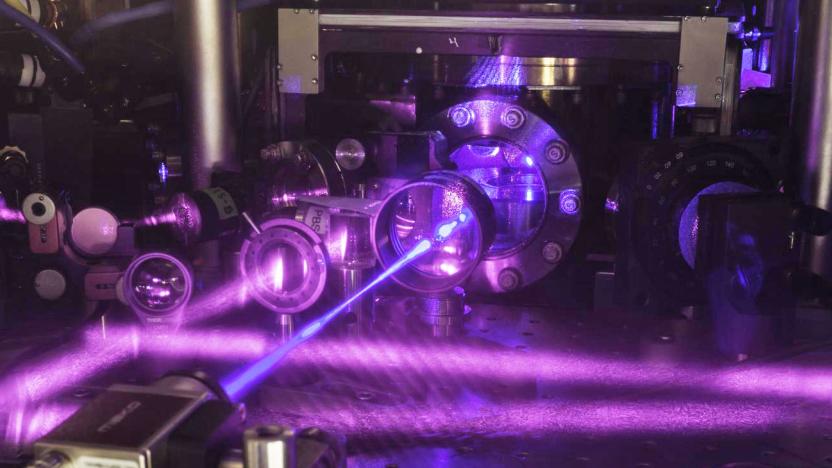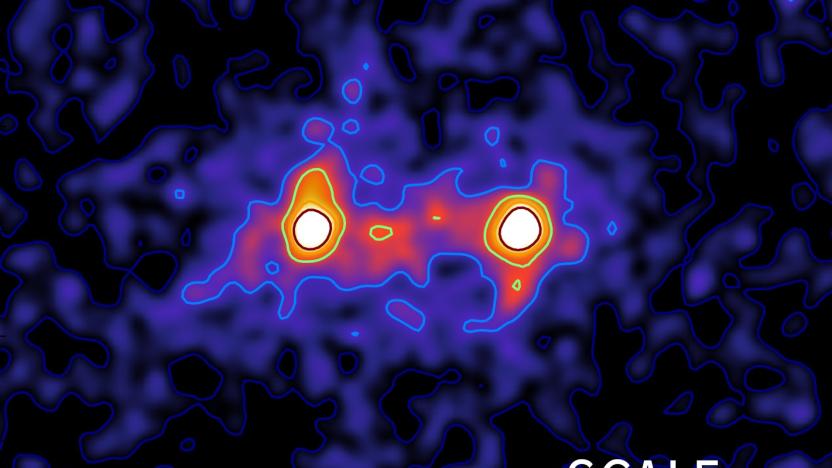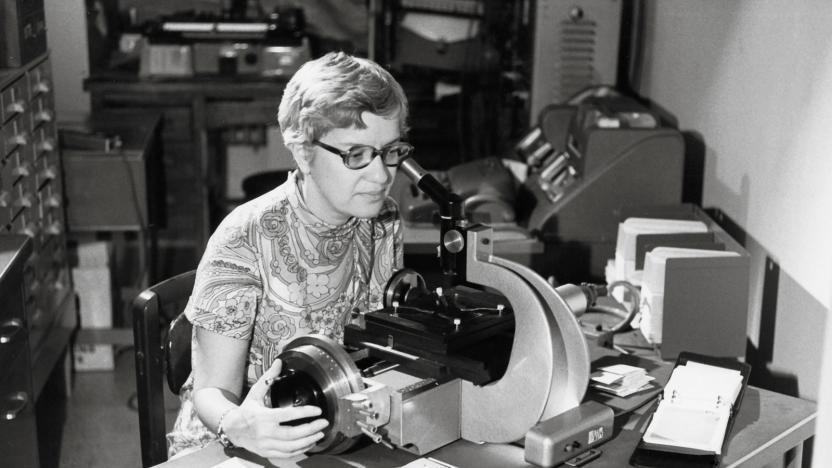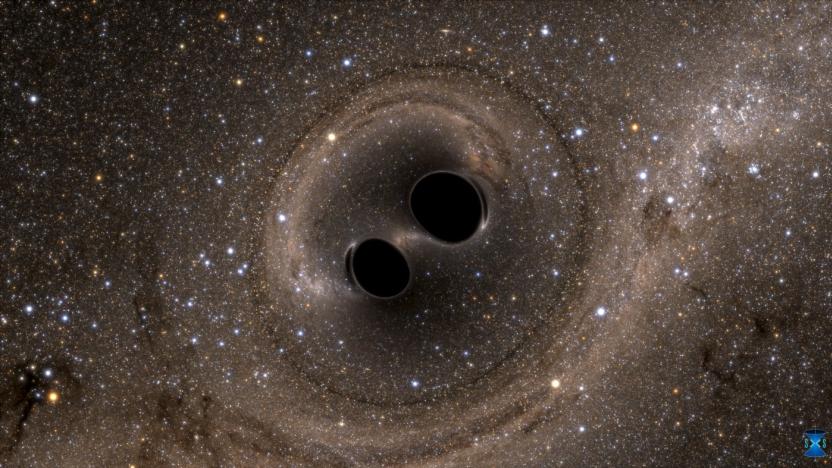darkmatter
Latest

Messaging app ToTok is reportedly a spying tool for the UAE
It's no secret that some messaging apps are favored by authoritarians, but one app may be explicitly designed with spying in mind. Unnamed US officials speaking to the New York Times say that the chat app ToTok is believed to be a surveillance tool for the United Arab Emirates. According to a classified intelligence report, the UAE uses ToTok to follow users' conversations, track locations (under the guise of weather), determine social connections and look at media. Most of the app's million of users live in the UAE, but it's popular elsewhere in the world and has seen a surge of demand in the US.
Jon Fingas12.22.2019
Researchers may have detected signals from the universe’s first stars
The early development of our universe is still quite a mystery, but in a new study published today in Nature, researchers describe what may be evidence of when the first stars began to form. After the Big Bang, which took place some 13.7 billion years ago, the universe was dark, hot and full of high-energy particles. Photons couldn't survive, but after around 380,000 years, the universe cooled enough to allow light to actually stick around. That's when the cosmic microwave background (CMB) came to be. It's our universe's first surviving radiation and researchers have looked to it in order to learn more about the earliest years of our universe.
Mallory Locklear02.28.2018
Physicists keep striking out in the search for dark matter
Space may be the final frontier, but we've barely begun to explore its underlying mechanics. For as much as humanity has discovered since we first looked to the heavens, we've only seen about five percent of the total matter in the universe. The other 95 percent -- the so-called "dark matter" -- well, we can't even figure out how to see yet. But that doesn't mean researchers from around the world aren't devising ways to do so.
Andrew Tarantola11.29.2017
Researchers have increased atomic clock precision yet again
Researchers have pushed the precision and stability of atomic clocks to increasingly greater levels over the last few years. A big advancement was the introduction of optical lattices, lasers which essentially quarantine individual atoms and boost accuracy by keeping them from moving around and interacting with each other. Scientists at the National Institute of Standards and Technology (NIST) have used this method to develop clocks so stable, they can keep extremely precise time for thousands and even billions of years. The team's most precise clock was created in 2015, but research published this week in Science describes a new version that just took that top spot.
Mallory Locklear10.06.2017
Astronomers create first image of dark matter web
See that image above? The one that looks like a cosmic rorschach test? That's the first composite image of a dark matter web that stretches between galaxies, according to a paper published in Monthly Notices of the Royal Astronomical Society.
Stefanie Fogel04.12.2017
Dark matter scientist Vera Rubin dies at 88
It's a sad time for the astrophysics world. Vera Rubin, who was instrumental to confirming the existence of dark matter, has died of dementia at the age of 88. While the concept of dark matter had been proposed by Fritz Zwicky back in 1933, it was Rubin and her colleague Kent Ford who provided firm evidence in the 1960s and 1970s. They noticed that the stars at the outside of spiral galaxies spin just as quickly as those on the inside -- according to the understanding of gravity at the time, these enormous star formations should tear themselves apart. The only viable explanation was an invisible mass, roughly 10 times larger than what we can see, that was holding everything together.
Jon Fingas12.26.2016
Strange galaxy is made almost entirely of dark matter
A galaxy isn't big just because it has many stars in it. A worldwide research group has discovered that a galaxy in the Coma cluster, Dragonfly 44, consists of 99.99 percent dark matter. It has about as much mass as our own Milky Way galaxy, but far fewer stars. The team determined the presence of the invisible, mysterious substance based on the motions of the stars themselves -- there were too few of them to be moving so quickly. If there weren't a gravitational force like dark matter to hold them together, those stars would simply fly away.
Jon Fingas08.27.2016
Dark matter might be made of black holes
So just what is dark matter made of? Astronomer Alexander Kashlinsky of the NASA Goddard Space Flight Center in Maryland thinks the mysterious cosmic stuff could be made of black holes that formed soon after the Big Bang.
David Lumb06.14.2016
'Goopy' dark matter could offer a new vision of the early universe
Cosmologists exploring the origins of the universe have a new theory about how dark matter behaves. Although the stuff makes up 80 percent of the matter in the universe, we don't really have a good sense of what dark matter is actually made of. According to The New Scientist, however, UT Austin professor Paul Shapiro and graduate student Bouha Li believe dark matter could be made up of bosons that clump together in "a strange, goopy state of matter called Bose-Einstein condensate."
Andrew Dalton05.10.2016
ICYMI: Dark matter search, the personal plane and more
#fivemin-widget-blogsmith-image-123513{display:none;} .cke_show_borders #fivemin-widget-blogsmith-image-123513, #postcontentcontainer #fivemin-widget-blogsmith-image-123513{width:570px;display:block;}try{document.getElementById("fivemin-widget-blogsmith-image-123513").style.display="none";}catch(e){}Today on In Case You Missed It: The new Icon A5 personal aircraft is available for $189,000, shrinking middle class be damned. China's space agency launched a spacecraft to hunt for signs of dark matter's existence. And Netflix's latest Make It project is a cosy nod to what too many of us will likely be doing over holiday breaks: Going on prolonged Netflix binges. The company is giving instructions for how to construct socks that will pause your show if you should fall asleep.
Kerry Davis12.18.2015
Dark matter is (probably) more complex than you think
Scientists typically believe that dark matter, for all of its mystery, behaves in a simple way: if one clump encounters another, the two interact solely through gravity. However, researchers using both Hubble and the Very Large Telescope have published findings which suggest that there's more involved. They've noticed dark matter (the blue lines in this picture) lagging behind a galaxy due to friction, hinting that there are factors beyond gravity at work. It's not certain whether the source of this friction is a familiar phenomenon or something entirely undiscovered, but it's definitely not the usual culprit.
Jon Fingas04.20.2015
The Large Hadron Collider is back and stronger than ever
Yes, it's back -- after a two-year upgrade program, CERN's Large Hadron Collider is once again operational. Scientists are only firing collision-free proton beams right now to test the new system, but they'll ramp up over the next few months to the point where they're smashing protons together at 13 teraelectronvolts -- about twice the energy the LHC managed in its first season. The machine will have a relatively short three years to operate before its next shutdown, but the higher output should help researchers explore antimatter, dark matter and other aspects of physics that are relatively untested. Given that the collider appears to have discovered the mysterious Higgs boson during its first run, we're hopeful that its second season has more breakthroughs in store. [Image credit: CERN]
Jon Fingas04.05.2015
The Big Picture: A far-away supernova split into four
Gravity can play a lot of tricks with light, and we're not just talking about black holes. Take this recent Hubble Space Telescope discovery from UC Berkeley's Patrick Kelly, for example: those four lights are actually a distant supernova magnified and split into four images by the gravitational lensing of a giant galaxy. Besides looking cool, the image promises to be a gold mine for astrophysics. The time delay between those four lights will let researchers study both the properties of the exploding star and the galaxy, including the presence of dark matter. The best part? Due to the light's unusual path, there's a good chance that scientists will get a "rerun" in a few years if they want to see it again. [Image credit: NASA/ESA/FrontierSN/GLASS/Frontier Fields]
Jon Fingas03.09.2015
Unusual X-ray signals could reveal dark matter
Dark matter remains one of the most mysterious elements of the universe, because it's completely invisible to us. It neither emits nor absorbs light, so we can't observe it directly -- not even if we use our most powerful telescope. A team of researchers believe that they've come across important data that could change that, though: data that could lead to equipment being built especially to observe dark matter. While studying the X-ray data collected by the European Space Agency's XMM-Newton spacecraft, the team came across a spike they couldn't identify. This signal, which came from the Andromeda galaxy and the Perseus galaxy cluster, matched no other signal scientists have observed before.
Mariella Moon12.13.2014
Engadget Live is coming to Austin on June 20th!
Austin, we love you. We mutually understand that things should be kept weird (otherwise, life would be boring). With that in mind, we're kicking off the Engadget Live series in the live music capital of the world: 7PM on June 20th at the Austin Music Hall! Austin's Chaotic Moon, the people behind this damn electricity-shooting helicopter will stun you with another incredible creation. Perhaps you want a life-sized replica of Oprah printed? Re3D's got you covered with the world's largest 3D printer. Building a robot? Charmed Labs' Pixy is a sensor that can teach it to find things and you'll get to check it out. Techjango, which brought us the Darkmatter Xbox laptop, will show off even more gadgets for makers. If that wasn't enough, AF1 Racing will bring its totally electric (and fast!) Zero Motorcycle so you can experience it yourself.
John Colucci05.01.2014
Scientists calculate the speed of free-roaming dark matter
When dark matter is the most pervasive substance in the universe, it's important that we know how quickly it can move. Thankfully, Syracuse University scientists may have just found that speed. By comparing distribution in the early universe with what we see today, researchers now estimate that free-roaming dark matter moves at 54 meters per second (177 feet per second). That's pokey in relation to other materials in space, and the calculation assumes that nothing gets in the way -- most dark matter is stuck in clumps. The number may not sound like much, but it could be vital to physicists wanting to test (and possibly prove) their theories about a very mysterious element. [Image credit: NASA]
Jon Fingas10.07.2013
Alt-week 09.15.13: Record-breaking glass, nature's gears, and Hubble's huge find
Alt-week takes a look at the best science and alternative tech stories from the last seven days. This week's alternative roundup focuses on exploration, experimentation and discovery -- both on land and in space. Here on Earth, Cornell's stumbled upon a new glass that breaks records and researchers in Europe have discovered an insect with cob wheel-styled gear joints for movement. Meanwhile, above our atmosphere, NASA's Hubble telescope made a large discovery of its own. This is alt-week.
Joe Pollicino09.16.2013
Darkmatter flaunts its Xbox 360 laptop Kickstarter project at Maker Faire
Darkmatter's portable open source Xbox 360 project may have hit Kickstarter with bad timing, but it looks to be drawing crowds all the same. The laptop-like console is available in fully finished or kit form for the Xbox 360, thanks to a 3D-printed, laser-cut casing, 15.6-inch 720P widescreen LED display, capacitive Arduino-based touch interface, a headphone jack and support for all native features, like WiFi, 4GB storage and DVD compatibility. Addressing concerns about the lame duck console it's working with, the group said in an update that it should be able to adapt the Xbox One's motherboard as well, though it's obviously never laid a hand on it yet. Any future-proofing concerns didn't dismay those who saw the device at Maker Faire, however, as most seemed enthusiastic about the project, including Ben Heck, who's been known to mod a device or two 75. You can pledge $499 for a full DIY kit (without the required Xbox 360 Slim 4GB), while a fully assembled and tested Darkmatter Xbox Laptop will run $999. Check the video after the jump or hit the Kickstarter page at the source link to ante up.
Steve Dent05.23.2013
AMS detects excess of positrons, could suggest existence of dark matter
We've been waiting with bated breath all afternoon to find out what NASA, MIT and the Department of Energy has observed with the Alpha Magnetic Spectrometer. Well, we still don't quite understand the exact nature of dark matter, but highly precise measurements of positron fraction (the ratio of positrons to electrons and protons) do bring us a small step closer to proving the existence of the theoretical material. The AMS found a small excess of positrons coming from all directions instead of a single source. That could indicate the presence of dark matter, which is believed to generate the antimatter particles when it collides and annihilates itself. As usual though, this is far from conclusive. The excess of positrons could be caused by a number of cosmic phenomenon, including pulsars, but researchers are hopeful that further testing will narrow down the possibilities. Those of you hoping for direct and obvious evidence of dark matter may be a little disappointed, but let's be honest -- you were being overly optimistic. Besides, don't you want some mysteries left to solve? For more information, check out the PR after the break.
Terrence O'Brien04.03.2013
PSA: Watch the AMS dark matter results announcement at 1:30PM ET (video)
The universe is thought to be composed of stuff, non-stuff and maybe some other stuff. We're referring, of course, to matter, anti-matter and as-yet illusive dark matter. While we know a fair amount about matter and its opposite, dark matter is still largely theoretical. That might change in around half an hour, though, as folks from NASA, MIT and the US Department of Energy hold a press conference to explain exactly what the Alpha Magnetic Spectrometer (AMS) strapped to the ISS has been seeing during almost two years of space-scanning. Samuel Ting from MIT, who will be on the panel, implied back in February that today's results will provide the first evidence of dark matter's existence -- if that's the right term. The press conference is due to start at 1:30PM EDT, so make sure to tune in to the NASA TV livestream embedded below for what could be the biggest scientific news since Higgs and his boson. [Image Credit: NASA]
Jamie Rigg04.03.2013